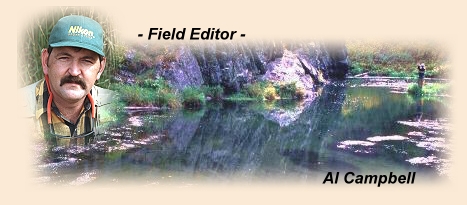|
When you look at it, this pattern isn't a
lot different from the extended body mayfly
of a couple of weeks ago. However, it has
a couple of characteristics that cause it to
look and fish a lot different from the other
fly. Not only is it a little easier to tie,
but when it's floating on the water, it presents
a different image to the fish looking at it from
underneath.
This fly has a shorter body than the other one,
and it could be used to represent more than a
mayfly if tied in the right sizes and colors.
Of course, as the photo suggests, it can also
represent a mayfly. It is just a little bit
more flexible that way.
By the way, this fly isn't totally my invention.
A few of years ago while visiting the
Bighorn Trout
Shop in Fort Smith Montana, they were selling
a fly called a "bunny baetis" that used a wing
made from dark dun snowshoe hare foot hairs.
Their version was more complex than mine, but
it was enough to cause me to buy a snowshoe
hare foot and create a simple version of the
baetis for myself. The fly performed well,
and it was a better floater than the CDC winged
versions I had been using for many years. A plus
was the fact that I could treat the fly with
floatant with no ill effects. I just tie the
fly a different way than they did, but I owe
the inspiration to the Bighorn Trout Shop.
I'm back to using one of my favorite simple
body materials too. I find the punch embroidery
yarn I use in this body too easy to ignore. It
takes floatant easily, won't absorb water as
easily as cotton will, and looks buggy when
used as a fly body. Add to all of that the
fact that you can buy it in a full array of
colors and a spool will last about a thousand
flies, and you have what might be a perfect
simple body material.
I fish this fly just about any time I see
emerging insects. That includes mayflies
and caddisflies. Sometimes I twitch it to
give it the appearance of life, and sometimes
I just drift it. The snowshoe hare wing keeps
the fly floating very well, but if it should
sink for some reason I usually let it swing
before I lift it out of the water for another
cast. It usually only takes a single false-cast
to dry the body and wing sufficiently to float
again.
As before, select the size, body color and wing
color to match the insect you want to imitate.
Tan, cream and dun are the most common colors
in the insect world, so I use those colors in
my bodies and wings. Since natural snowshoe
hare feet have hairs that range from cream to
tan, that covers those colors. Dun dyed feet
are also available from select suppliers.
Hunters
Angling Supplies, has natural and three
shades of dun dyed feet for sale. Some of the
local shops also carry snowshoe hare feet, so
check out your local supplier before
you start a broad search. I think you'll find
snowshoe hare feet to be just about as useful
as CDC, maybe even more useful.
Materials TS Bunny Emerger
- Hook - Any standard fly hook, even cheap ones
will do. I'm using a size 16 Eagle Claw dry fly hook.
- Tail - none.
- Body - Punch embroidery yarn. I'm using
golden tan for this fly (PMD colors) but you
can use any color needed to match the hatch.
- Legs - None.
- Thread - 6/0 - Colored to match the body.
- Wing - Stiff hairs from the foot of a snowshoe
hare. I'm using light dun, but you can use any color
to match the hatch. If you can't find the right color,
the feet can be dyed, or colored with a waterproof
marker.
Tying steps TS Bunny Emerger:

1. Start the thread.

2. Secure the punch embroidery yarn to the hook.

3. Leaving the thread to the rear, wrap a
yarn body to just behind the hook eye, as shown.

4. Bring the thread forward and over the
hook in front of the yarn.

5. Now wrap the thread behind the yarn to tie it off.

6. Trim the tag end of yarn.

7. Select a small bunch of snowshoe hare
foot fibers and secure them to the hook so that
the hairs extend slightly past the bend of the
hook.

8. If you want to, make a wrap or two of
thread around the base of the wing to help it
stand more upright, but you still want the wing
to slant backward a little. When you have the
wing secure, trim the hair ends that extend over
the hook eye.

9. Build a nice head and whip finish. I
usually add a drop of head cement to secure the
head and wing. Your finished fly should look
something like this.
Is that simple enough? Do you think you could use
this pattern to imitate other insects? One thing
is certain; you can use this simple pattern to fill
a fly box in a hurry. I also think you'll like the
way it catches fish when you try it on the water.
Warmwater folks, try this pattern for bluegills
sometime. I think you'll like the results.
~ AC
|











